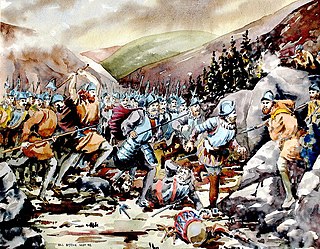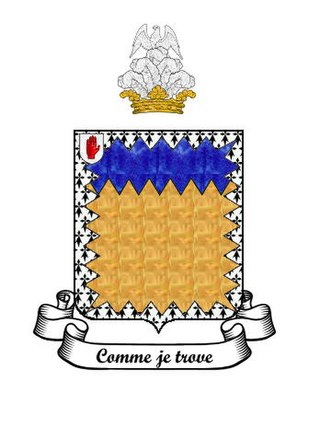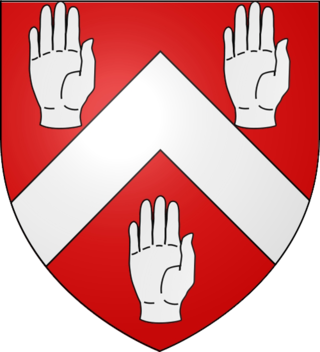
The Battle of Glenmalure took place in Ireland on 25 August 1580 during the Desmond Rebellions. A Catholic army of united Irish clans from the Wicklow Mountains led by Fiach MacHugh O'Byrne and James Eustace, 3rd Viscount Baltinglass of the Pale, defeated an English army under Arthur Grey, 14th Baron Grey de Wilton, at Clan O'Byrne's mountain stronghold of Glenmalure.

The Rt Hon. Arthur Grey, 14th Baron Grey de Wilton, KG (1536–1593), was a baron in the Peerage of England. Lord Grey de Wilton is now largely remembered for his memoir of his father, for participating in the last defence of Calais (1558), and for his involvement in the massacre after the Siege of Smerwick (1580) on Corca Dhuibhne in County Kerry. He served as Lord Deputy of Ireland from 1580 until 1582.

Fiach mac Aodha Ó Broin was Chief of the Name of Clann Uí Bhroin and Lord of Ranelagh during the Elizabethan wars against the Irish clans.

Rory Oge O'More was an Irish noble and chief of the O'More clan. As the Lord of Laois, he rebelled against the Tudors' sixteenth-century conquest of Gaelic Ireland.
The Second Desmond Rebellion (1579–1583) was the more widespread and bloody of the two Desmond Rebellions in Ireland launched by the FitzGerald Dynasty of Desmond in Munster against English rule. The second rebellion began in July 1579 when James FitzMaurice FitzGerald landed in Ireland with a force of Papal troops, triggering an insurrection across the south of Ireland on the part of the Desmond dynasty, their allies, and others who were dissatisfied for various reasons with English government of the country. The rebellion ended with the 1583 death of Gerald FitzGerald, 14th Earl of Desmond, and the defeat of the rebels.

Planxty is the first album by the Irish folk group Planxty, recorded in London during early September 1972 and released in early 1973.
Patrick Joseph McCall known as "P.J. McCall" was an Irish songwriter, historian, and poet, known mostly as the author of lyrics for popular ballads. He was assisted in putting the Wexford ballads, dealing with the 1798 Rising, to music by Arthur Warren Darley using traditional Irish airs. His surname is one of the many anglicizations of the Irish surname Mac Cathmhaoil, a family that were chieftains of Kinel Farry in County Tyrone. McCall's ancestors relocated from Tyrone to Carlow in the early 1600s.
Sir Nicholas White was an Irish lawyer, judge, privy councillor and government official during the reign of Elizabeth I.
Events from the year 1582 in Ireland.
Events from the year 1597 in Ireland.
James FitzEustace of Harristown, 3rd Viscount Baltinglass (1530–1585) James FitzEustace, the eldest son of Rowland Eustace, 2nd Viscount Baltinglass and Joan, daughter of James Butler, 8th Baron Dunboyne.
Emmett O'Byrne is an Irish historian whose primary research interests are the history of Medieval Ireland and Early Modern Ireland, focusing in particular on Gaelic Ireland. Further research interests include the development of the common law in Ireland from 1169, competing laws among the marches of medieval Ireland and the peoples and frontiers of medieval Europe.

Sir Thomas Butler, 1st Baronet of Cloughgrenan, was an Irish nobleman.

The O'Byrne family is an Irish clann that descend from Bran mac Máelmórda, King of Leinster, of the Uí Faelain of the Uí Dúnlainge. Before the Norman invasion of Ireland they began to colonise south Wicklow. There are many famous people with this Irish last name. This includes Anna O’Byrne, an Australian singer and actress, and Anna Marie O’Byrne, an American model.
Henry MacShane O'Neill was an Irish flaith (nobleman) and a son of Shane O'Neill. He was the leader of the MacShanes in the late 16th century and early 17th century, and sought control of the O'Neill Clan, fighting with his brother Art against Hugh O'Neill.
Cahir mac Art Kavanagh, "The MacMurrough" and King of Leinster, also Lord of St. Molyns, and baron of Ballyann, was an Irish magnate of the Tudor period.
Events from the year 1580 in Ireland.

On 16 February 1595, a Gaelic Irish force assaulted and captured the English-held Blackwater Fort at Blackwatertown in County Armagh. The Irish were led by Art MacBaron O'Neill, brother of Hugh O'Neill, Earl of Tyrone, and marked Tyrone's break with the English Crown as he openly waged war against the English forces in Ireland.
Owny MacRory O’More was an Irish chieftain and rebel.







